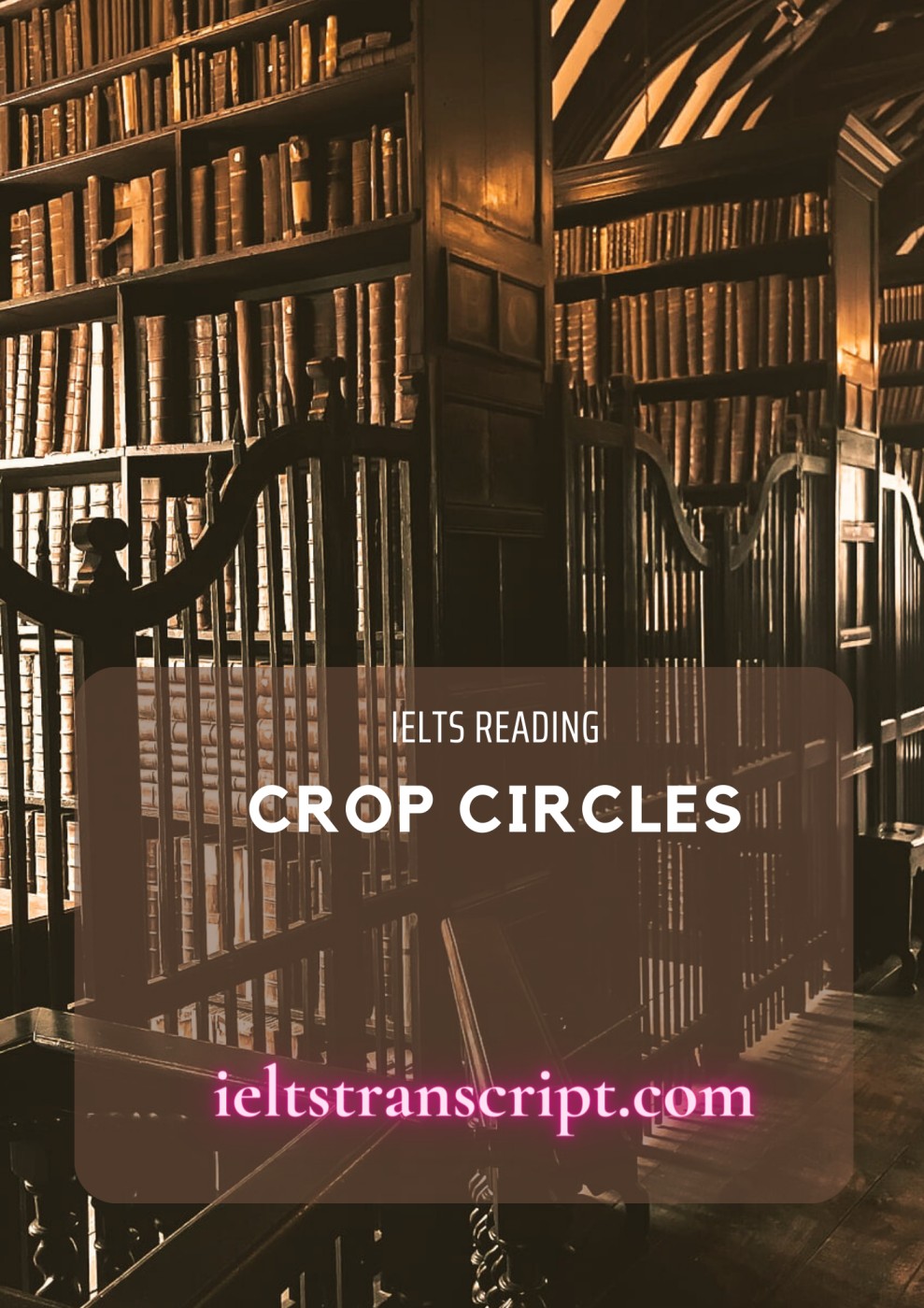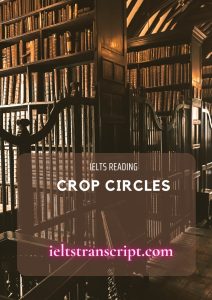- Đối với sản phẩm có giá: Sau khi chúng tôi ghi nhận thông tin đã thanh toán sản phẩm của bạn, sản phẩm sẽ được mở khóa và bạn có thể xem trực tiếp và tải tài liệu sản phẩm.
- Đối với thành viên trả phí: Bạn có thể mua và thanh toán sản phẩm với giá 0đ để tải tài liệu sản phẩm.
- Bạn có thể liên hệ với chúng tôi để được hỗ trợ mở khóa sản phẩm sớm nhất.
Crop circles
- Chúng tôi chấp nhận các phương thức thanh toán sau đây: Thẻ tín dụng, thẻ ghi nợ, PayPal, chuyển khoản ngân hàng và tiền mặt.
Chúng tôi sẽ không thu thêm phí cho bất kỳ hình thức thanh toán nào.
- Nếu bạn gặp vấn đề về sản phẩm của chúng tôi trong thời gian sử dụng, vui lòng liên hệ với chúng tôi để được hỗ trợ xử lý sớm nhất nhé.
Xem trước mẫu
Crop circles
The crop circle phenomenon has puzzled and mystified humanity for many years. The designs just appear, placed carefully in fields of food grains. Some are larger than football fields and highly complex in design and construction. Others are smaller and more primitive. We call them crop circles, but many of them are not circular. Some are elongated abstract designs, a few resemble insects or other known forms, and some are mixtures of lines, circles, and other shapes melded into intricate patterns. Most become visible overnight, though it has been claimed that a few have appeared within a half-hour in broad daylight.
Crop circles have appeared all over the world. About 10,000 instances from various countries have been reported in recent years. The first modern rash of crop circles appeared in Australia in December of 1973. A strange circular imprint appeared in a wheat field near Wokurna, a community southeast of Adelaide. Soon seven swirled circles up to 14 feet in diameter appeared in an oatfield nearby. In December of 1989, an amazing set of circles, ranging from a few inches to a few feet in diameter appeared in the wheat best west of Melbourne. As many as 90 crop circles were found. The best documented and largest modern spread of crop circles began in southern England during the summer of 1980. By the end of 1988, 112 new circles had been formed. At that time circles were being reported worldwide, 305 by the end of 1989. The total grew to an outstanding 1,000 newly -formed circles in 1990. In 1991,200 to 300 circles were reported. Crop circles have been documented in over 30 countries, including Canada, the former Soviet Union Japan and the United States.
Nine out of ten circles remained simple with broken stems flattened to the ground and swirled. The stalks around the circles remained completely erect. But over the years, crop circles have become much more geometrically intricate. Patterns involved multiple circles, bars, triangles, rings and spurs. Pictorial imagery also appeared. Reliable eyewitnesses have reported seeing unusual lights and hearing unidentifiable sounds while on an early-morning walk in the countryside where a crop circle showed later that day. High-pitched, warbling, noises have been recorded at the site of some crop circles. On several occasions a strange glow or a darker colouring has been seen in the sky over a crop circle. And in more than one instance, the electrical power of small planes flying overhead has been cut off abruptly. While the causal energies do not seem to harm animals, or even insects as far as we can tell, wild creatures tend to avoid the circles. Flocks of birds have been seen to split apart and fly around the perimeter rather than go directly over a crop circle formation.
Researchers have spent a great deal of time investigating different aspects of crop circles. They try to detect traces of human involvement in the circle-making, test the area of the circle itself for geophysical anomalies, and analyze the field’s grain both from within and outside the circles, searching for differences.
Dr. W. C. Levengood of BLT Research in Cambridge, Massachusetts, has analyzed many grain samples and confirmed, time after time, significant changes at the cellular level of crop circle plants. The plants front the circles have elongated cells and blown-out growth nodes. Seeds front the circle plants often show accelerated growth rates when they are sown, and in some instances, quite different-looking plants result. In many instances it appears that a vortex-like energy causes the plants to swirl down, flattening the design into the land. Whatever this energy is, it does not generally inhibit the plants’ growth. They continue to show normal response to the sun, raising upward over several days following the appearance of the circle. Michael Chorost of Duke University found occasions of short-lived radionuclides in the top layer of soil in some of the formations. A British
...Những vòng tròn trên cánh đồng
Hiện tượng những vòng tròn trên cánh đồng đã khiến cả nhân loại bối rối và hoang mang suốt nhiều năm. Các hình vẽ bỗng dưng xuất hiện, được đặt ngay ngắn trong các cánh đồng trồng cây lương thực có hạt. Một số lớn hơn sân bóng đá và có độ phức tạp cao về mặt thiết kế và tạo hình. Số khác nhỏ và đơn giản hơn. Chúng ta gọi đó là những là vòng tròn trên đồng, nhưng rất nhiều trong số ấy không phải là hình tròn. Một số là các hình trừu tượng thon dài, một số trông giống côn trùng hoặc các hình dạng có thể hiểu được, và một số là sự kết hợp của các đường thẳng, đường tròn và các hình dạng khác được kết hợp lại thành các hình phức tạp. Hầu hết chúng được nhìn thấy chỉ sau một đêm, mặc dù có một vài trường hợp được cho là xuất hiện trong vòng nửa giờ ngay giữa ban ngày.
Những vòng tròn trên cánh đồng đã xuất hiện khắp nơi trên thế giới. Đã có khoảng 10.000 trường hợp được báo cáo từ nhiều quốc gia khác nhau trong những năm gần đây. Phát hiện đầu tiên trong thời hiện đại về vòng tròn trên cánh đồng xuất hiện ở Úc vào tháng 12 năm 1973. Một dấu vết hình tròn kỳ lạ xuất hiện trên một cánh đồng lúa mì gần Wokurna, một cộng đồng dân cư ở phía đông nam Adelaide. Ngay sau đó, bảy vòng tròn dạng xoáy có đường kính lên tới 14 feet xuất hiện tại một cánh đồng yến mạch gần đó. Vào tháng 12 năm 1989, một loạt các vòng tròn đáng kinh ngạc, có đường kính từ vài inch cho đến vài feet đã xuất hiện ở vùng trồng lúa mì tốt nhất ở phía tây Melbourne. Có tới 90 vòng tròn trên đồng đã được tìm thấy. Các vòng tròn nằm trải dài trên một diện tích lớn nhất thời hiện đại từng được ghi nhận khởi đầu ở miền nam nước Anh vào mùa hè năm 1980. Cho tới cuối năm 1988, 112 vòng tròn mới đã được hình thành. Vào thời điểm đó, sự xuất hiện các vòng tròn đã được báo cáo trên khắp thế giới, 305 trường hợp vào cuối năm 1989. Tổng số đã tăng lên 1.000 vòng tròn mới hình thành vào năm 1990. Năm 1991, có tới 300 vòng tròn được báo cáo. Vòng tròn trên đồng đã được ghi nhận ở hơn 30 quốc gia, bao gồm Canada, Liên Xô cũ, Nhật Bản và Hoa Kỳ.
Chín trong số mười vòng tròn trông đơn giản với những thân cây gãy đổ xuống đất và bị cuộn lại. Các thân cây xung quanh những vòng tròn vẫn hoàn toàn đứng thẳng. Tuy vậy trong những năm qua, các vòng tròn trên đồng đã trở nên phức tạp hơn nhiều về mặt hình học. Các mẫu hình khối bao gồm nhiều dạng hình tròn, chữ nhật, hình tam giác, vòng và chóp. Các hình ảnh cũng được xuất hiện. Những nhân chứng đáng tin cậy đã báo cáo lại rằng họ đã nhìn thấy những nguồn ánh sáng bất thường và nghe thấy những âm thanh không xác định khi đang đi dạo vào buổi sáng sớm ở vùng nông thôn, nơi một vòng tròn trên cánh đồng xuất hiện vào cuối ngày hôm đó. Các tiếng ồn dưới dạng âm thanh tần số cao, tiếng róc rách đã được ghi nhận tại địa điểm mà một số vòng tròn xuất hiện. Đôi khi, người ta nhìn thấy luồng ánh sáng kỳ lạ hoặc dải màu tối hơn lướt qua bầu trời phía trên một vòng tròn. Và đã có hơn một lần, nguồn điện của những chiếc máy bay nhỏ đang bay trên cao đã bị ngắt đột ngột. Trong khi năng lượng tỏa ra dường như không gây hại cho động vật, hoặc thậm chí côn trùng theo những gì chúng ta từng biết đến, các loài động vật hoang dã có xu hướng tránh những vòng tròn này. Các quan sát cho thấy những đàn chim đã tách ra và bay xung quanh vòng tròn thay vì bay trực tiếp ngang qua phía trên khu vực vòng tròn.
Các nhà nghiên cứu đã dành rất nhiều thời gian để điều tra các khía cạnh khác nhau của những vòng tròn trên đồng. Họ cố gắng phát hiện dấu vết sự tham gia của con người trong việc tạo ra vòng tròn, kiểm tra toàn bộ khu vực vòng tròn để tìm các điểm bất thường về địa vật lý, và phân tích các hạt của cây trồng cả bên trong và bên ngoài vòng tròn nhằm tìm ra sự khác biệt.
Tiến sĩ WC Levengood đến từ BLT Research ở Cambridge, Massachusetts, đã phân tích nhiều mẫu hạt và rất nhiều lần xác nhận có những thay đổi đáng kể ở cấp độ tế bào của các loại cây trong vòng tròn. Các cây phía trên mặt vòng tròn có các tế bào kéo dài và các nốt
...Để xem được đầy đủ nội dung và tải dữ liệu, bạn phải trở thành thành viên của chúng tôi và trả phí cho tài liệu (nếu có)











